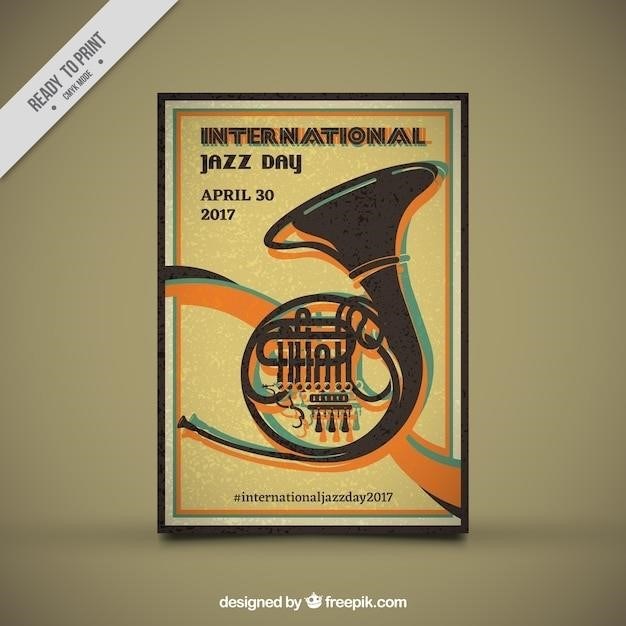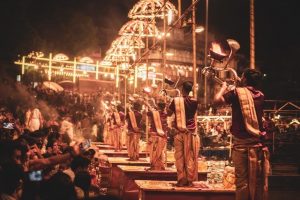
Pictures at an Exhibition⁚ A Guide to Trumpet Parts
This comprehensive guide delves into the trumpet parts of Mussorgsky’s iconic suite, “Pictures at an Exhibition,” providing resources for finding, learning, and performing this timeless masterpiece․

A Brief History of “Pictures at an Exhibition”
“Pictures at an Exhibition” is a celebrated suite in ten movements composed for piano by Modest Mussorgsky in 1874․ The work was inspired by an exhibition of paintings by Mussorgsky’s friend, Viktor Hartmann, who had tragically passed away the previous year․ Each movement of the suite corresponds to a specific painting from the exhibition, with the “Promenade” theme serving as a connecting thread between them․
Mussorgsky’s original piano score was later orchestrated by Maurice Ravel in 1922, giving the work a new dimension and popularity․ Ravel’s orchestration, with its vibrant colors and dramatic contrasts, became the definitive version of the suite, enjoyed by audiences worldwide․ The suite is a powerful and evocative journey through Hartmann’s artistic vision, showcasing Mussorgsky’s unique musical voice and dramatic storytelling abilities․
The Trumpet’s Role in the Suite
While the trumpet doesn’t take center stage in every movement of “Pictures at an Exhibition,” it plays a significant and often impactful role throughout the suite; The trumpet’s characteristic bright and assertive sound often serves to heighten the drama and grandeur of the music․ In movements like “The Great Gate of Kiev,” the trumpet’s soaring lines add to the majestic and celebratory atmosphere․
The trumpet can also be used to create a sense of urgency and excitement, as seen in the “Promenade” theme, which often features the trumpet in a prominent role․ Its piercing call helps to drive the music forward, creating a sense of momentum and anticipation․ The trumpet’s versatility allows it to contribute to the suite’s rich tapestry of sound, from the grandiose and heroic to the more intimate and reflective passages․
Finding Trumpet Parts Online
The digital age has made accessing sheet music for “Pictures at an Exhibition” incredibly convenient․ Several websites offer trumpet parts for the suite, both free and paid, catering to various levels of musicians․ One valuable resource is 8notes․com, which features free sheet music for the “Promenade” theme․ For those seeking a more comprehensive orchestral experience, Brass Music Online offers a full set of transposed trumpet parts for the entire suite, suitable for both individual study and ensemble performance․
Carnegie Hall provides free trumpet excerpts for educational purposes, including a portion of the “Promenade” from “Pictures at an Exhibition,” offering a glimpse into the trumpet’s role in the suite․ Furthermore, Alfred Music provides digital sheet music downloads for the first B-flat trumpet part, making the suite accessible to a wider range of trumpet players․ These online platforms provide a wealth of resources, allowing musicians to easily locate and access the trumpet parts for “Pictures at an Exhibition․”
Free Trumpet Sheet Music Resources
While acquiring complete, professional-quality orchestral parts might require a paid subscription, several online platforms offer free trumpet sheet music for “Pictures at an Exhibition,” providing a valuable starting point for aspiring trumpet players․ One notable resource is 8notes․com, where you can download and print free sheet music for the “Promenade” movement, a foundational piece in the suite․ This resource provides a valuable opportunity to explore the trumpet’s role in this iconic work without financial constraints․
Furthermore, Carnegie Hall offers a selection of free trumpet excerpts for educational purposes, including a portion of the “Promenade” from “Pictures at an Exhibition․” These excerpts, intended for study and practice, provide a taste of the trumpet’s contribution to the suite, allowing aspiring musicians to gain a sense of the musical texture and intricacies involved․ These free online resources make “Pictures at an Exhibition” accessible to a broader range of trumpet players, fostering musical exploration and development․
Paid Trumpet Sheet Music Resources
For those seeking a comprehensive and professional-grade experience, paid sheet music resources offer a wealth of options for “Pictures at an Exhibition” trumpet parts․ “Brass Music Online” provides a full set of orchestral trumpet parts, transposed and written for ease of page turning, catering to the demands of advanced musicians․ These parts, available as digital downloads, ensure a smooth and efficient performance experience, ideal for ensembles and professionals․
Alfred Music, a reputable publisher, offers a digital sheet music download for the 1st B-flat trumpet part of “Pictures at an Exhibition,” arranged by Patrick Roszell․ This arrangement, designed for educational purposes, exposes students to the complexities and nuances of the trumpet’s role in this masterpiece, providing a valuable learning tool for aspiring musicians․ These paid resources offer not only high-quality sheet music but also the support and expertise of renowned publishers, ensuring a comprehensive and enriching musical experience․
Exploring Trumpet Excerpts
Delving deeper into the intricacies of “Pictures at an Exhibition” for trumpet, exploring excerpts allows musicians to focus on specific sections and hone their performance skills․ “Trumpet Excerpts,” a dedicated online resource, provides a comprehensive library of trumpet excerpts from various composers, including Mussorgsky’s “Pictures at an Exhibition․” These excerpts are often accompanied by audio recordings, providing a valuable tool for learning phrasing, articulation, and stylistic nuances․
Within “Trumpet Excerpts,” the “Promenade” movement from “Pictures at an Exhibition” is a popular choice for study and performance․ The website offers multiple recordings of the “Promenade” by renowned conductors and orchestras, allowing trumpeters to compare interpretations and refine their own performance approach․ This exploration of excerpts not only enhances technical proficiency but also deepens understanding of the musical context and stylistic intricacies of the trumpet parts in “Pictures at an Exhibition․”

“Pictures at an Exhibition” for Trumpet⁚ Performance Considerations
Performing “Pictures at an Exhibition” on trumpet requires careful consideration of various musical and technical elements․ The “Promenade” theme, a recurring motif throughout the suite, presents a unique challenge for trumpeters․ Its lyrical nature necessitates precise intonation and a smooth, legato style․ Trumpeters must also be aware of the dynamic shifts within the “Promenade,” transitioning seamlessly between soft, introspective passages and powerful, triumphant moments․
Beyond the “Promenade,” individual movements offer distinct performance considerations; “The Great Gate of Kiev,” for example, demands exceptional breath control and stamina due to its extended high notes and dynamic range․ Trumpet players must also be mindful of the contrasting moods and musical textures within each movement, adjusting their tone and articulation accordingly․ Successfully navigating the nuances of “Pictures at an Exhibition” requires a deep understanding of the composer’s intent and the ability to translate that understanding into a compelling and nuanced performance․
Transposed Trumpet Parts
Trumpet parts in “Pictures at an Exhibition” are typically written in the key of C, which is the standard concert pitch for orchestral instruments․ However, trumpet players typically play in the key of Bb, requiring a transposition to match the written score․ This transposition involves shifting the notes up a whole step, so a written C note would be played as a Bb on the trumpet․ This process ensures that the trumpet’s sound aligns with the intended pitch of the orchestra․
Transposed trumpet parts are readily available online and in print․ Several websites offer digital downloads of “Pictures at an Exhibition” trumpet parts in both Bb and C, making it convenient for trumpeters to access and study the music․ These transposed parts are essential for trumpeters to accurately perform the piece, ensuring that their notes match the intended harmony and pitch of the composition․
Learning “Pictures at an Exhibition” on Trumpet
Learning “Pictures at an Exhibition” on trumpet can be a rewarding and challenging journey․ The piece showcases a wide range of musical techniques, from lyrical melodies to dramatic flourishes, requiring careful attention to articulation, phrasing, and dynamics․ The “Promenade” theme, with its repeated motif, is a good starting point to familiarize yourself with the piece’s melodic structure and rhythmic patterns;
To effectively learn the piece, it’s essential to break it down into manageable sections․ Start with the “Promenade” theme and practice it slowly, focusing on accuracy and clarity․ Gradually increase the tempo as you become more comfortable with the notes and rhythms․ Once you’ve mastered the basic sections, move on to the more challenging passages, such as the “The Great Gate of Kiev” finale, which requires a high level of technical proficiency and stamina․
Remember to practice with a metronome to develop a steady tempo and rhythm․ Pay attention to the dynamics and phrasing indicated in the score, and strive for a musically expressive performance․ By practicing diligently and focusing on the nuances of the piece, you can unlock the full potential of “Pictures at an Exhibition” on trumpet․
“Pictures at an Exhibition” for Trumpet⁚ A Timeless Masterpiece
Modest Mussorgsky’s “Pictures at an Exhibition” transcends time as a timeless masterpiece․ The suite’s vibrant imagery, evocative melodies, and dramatic shifts in mood captivate audiences across generations․ The trumpet parts, while often playing a supporting role, contribute significantly to the piece’s dynamic range and emotional depth․ The “Promenade” theme, with its recurring motif, acts as a unifying thread throughout the suite, while the other movements, such as “The Great Gate of Kiev,” showcase the trumpet’s powerful and majestic sound․
The suite’s enduring popularity is a testament to its universality and accessibility․ Whether played by a single performer or a full orchestra, “Pictures at an Exhibition” evokes a sense of wonder and awe, transporting listeners to a world of artistic inspiration and imagination․ The trumpet, with its distinctive voice, plays a vital role in bringing this world to life, adding a layer of brilliance and drama to the musical tapestry․ Learning and performing “Pictures at an Exhibition” on trumpet offers a unique opportunity to connect with this timeless masterpiece and experience its enduring power․





No comment yet, add your voice below!